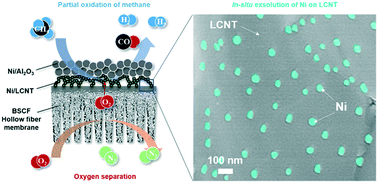Tailoring of a catalyst La0.8Ce0.1Ni0.4Ti0.6O3−δ interlayer via in situ exsolution for a catalytic membrane reactor
Abstract
The application of catalytic membrane reactors (CMRs) based on a perovskite-type oxygen-permeable membrane has been greatly limited by the instability of a membrane material. In this study, A-site deficient perovskite La0.8Ce0.1Ni0.4Ti0.6O3−δ (LCNT) as a modification porous interlayer (between a Ni/Al2O3 catalyst and membrane) was applied on a Ba0.5Sr0.5Co0.8Fe0.2O3−δ (BSCF) four-channel hollow fiber membrane to construct a CMR. Ni nanoparticles were in situ exsolved from the LCNT surfaces and used for partial oxidation of methane (POM). The porous LCNT layer shows excellent attachment, effective protection and enhanced catalytic activity to the BSCF four-channel hollow fiber membrane. The LCNT/BSCF CMR shows a more than 700 h stability in POM which is much higher than that without the modification of the LCNT porous layer (which is less than 150 h). At 900 °C, more than 99% CH4 conversion and CO selectivity have been achieved in the LCNT/BSCF CMR. Our results have demonstrated the feasibility of coupling an in situ exsolution Ni nano-catalyst porous layer with the perovskite-type membrane, providing a new strategy for enhancing both the stability and catalytic activity of CMRs.

- This article is part of the themed collection: Catalytic Membrane Reaction Chemistry


 Please wait while we load your content...
Please wait while we load your content...